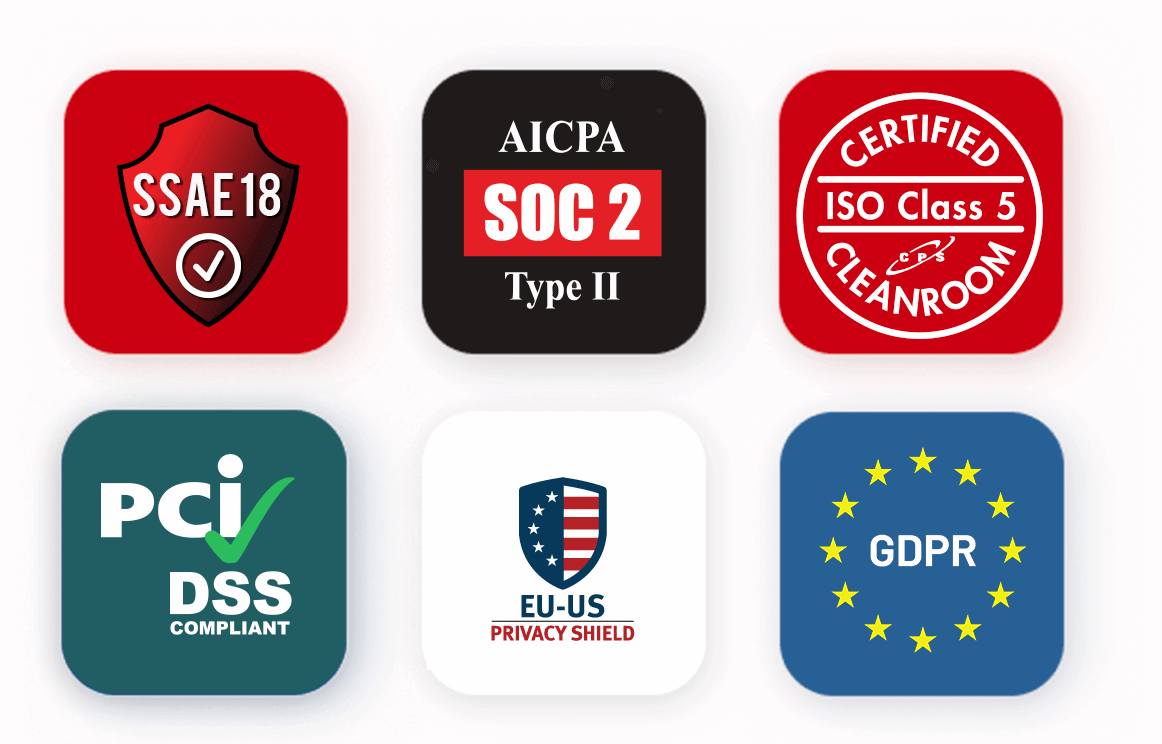
Trusted by Global Enterprises
We have the technology, security measures, and expertise to recover your data after a cyber attack. Among our satisfied clients are international giants like Coca-Cola, Facebook, Google, AT&T, Sony, NASA, and numerous others based around the globe.
Urgent steps to take during a ransomware attack: Separate affected devices by detaching them from other systems without delay!
Note: Detaching is different from powering off.
If detaching devices from your network isn’t feasible, your next best move is to switch them off to curb further infection spread. However, shutting down the compromised device could potentially delete vital evidence stored in volatile memory. Resort to this only if absolutely no other alternatives are on hand.
Collaborating quickly with our ransomware recovery solutions in the face of a ransomware crisis can help limit data and system damage, enhancing the likelihood of regaining your invaluable data.
Ransomware Data Recovery Services for Every Attack
Our specialists use various specifically designed tools and methodologies focused on retrieving data compromised during a ransomware attack and identifying unaffected data repositories.
- Fixing the structural damage inflicted by encryption on crucial files like virtual disks, backup files, and databases
- Undoing the harm caused by the threat actor through utilising or altering decryptors
- Mending corrupted files following decryption
- Recovering previous or alternative versions of the data
- Exploring and restoring from alternative data sources, such as tape and cloud resources
No matter the scale or severity of the ransomware attack, our data recovery solutions are optimised to help you recover your data as quickly and efficiently as possible.
It is critical to contact DriveSavers as soon as possible for optimal data recovery success, whether or not you’ve already contacted the threat actor. We provide a free consultation to help you understand appropriate courses of action and review alternative, less expensive, and more time-effective solutions. It should be noted that paying the ransom does not ensure that the victim will receive the decryption key or regain access to their files.
Mike Cobb – Director of Engineering at DriveSavers Data Recovery
Ransomware attackers commonly focus on sensitive or high-value data owned by individuals, enterprises, or institutions. Such targets are generally more inclined to pay a ransom due to the high stakes involved, be it data loss, monetary repercussions, or damage to reputation.
Before engaging with the threat actor, get in touch with us to explore how our ransomware data recovery services can help. Opting for our specialist ransomware recovery solutions could result in more successful data retrieval compared to paying the financial demands of the attacker.




Introduction to Ransomware
Ransomware has become one of the most serious cyber security threats in recent years, affecting people just like you, businesses, and almost every kind of organisation.
Ransomware is malicious software that infiltrates a computer or network, encrypts the user’s data, and then demands payment for the decryption key. The main objective behind ransomware attacks is financial profit, as the criminals aim to extract money from their victims.
Ransomware exists in multiple forms, each employing its unique encryption techniques and tactics. Though they share the common goal of holding data for ransom, other risks and aims are also often involved. For example, certain ransomware attackers may increase pressure on the victim by threatening to disclose confidential information publicly.
Realising that these attacks aren’t solely focused on capturing and destroying data is crucial. More often than not, the attackers aim to keep the victim’s data hostage or to publicly expose it unless a ransom is paid.
Ransomware poses a significant cybersecurity threat, affecting businesses, governmental bodies, and individual users. It exploits vulnerabilities within a computer system or network, often through phishing emails, malicious downloads, or compromised websites.
Once infiltrated, ransomware rapidly disseminates, encrypting or locking files and requiring payment for release. The consequences for an organisation can be severe, leading to data loss, financial loss, harm to reputation, and possible legal implications.
The objective of ransomware is to extract money from victims by locking or encrypting their data and sometimes by removing it from their systems. This is typically accomplished through:
- Employing diverse attack methods to penetrate a computer or network.
- Utilising sophisticated encryption algorithms for locking files or systems.
- Demanding a ransom from the victim in return for the decryption key.
- Applying pressure through deadlines and threats of data deletion or public exposure.
- Occasionally extracting confidential information to use as added leverage
Crypto-malware is a broad term that encompasses various forms of malicious software, including ransomware. This type of malware utilises cryptographic techniques to hide its actions, encrypt data, or financially exploit victims. Ransomware is a prominent example of crypto-malware. It employs encryption methods to lock up a victim’s files and then demands payment, usually in cryptocurrency.
Other varieties of crypto-malware include cryptojacking, which covertly mines cryptocurrency using the victim’s computer resources, and cryptolockers, which encrypt files but do not demand a ransom.
Understanding Ransomware
To defend against and respond to ransomware attacks effectively, it is vital to understand how they exploit vulnerabilities and what they seek to accomplish.
Ransomware commonly breaches a computer or network through various channels like phishing emails, malicious file attachments, compromised websites, or exploiting existing software vulnerabilities. Once inside, it encrypts the user’s files or locks down the system, making the data unattainable.
After successfully encrypting the data, the ransomware presents a ransom note on the screen. This message outlines the steps the victim must take to pay the ransom, typically demanded in cryptocurrency, and also specifies a payment deadline. Should the deadline not be adhered to, the attackers may escalate their threats — potentially deleting the encrypted files, raising the ransom amount, or exposing confidential information, underscoring the need for effective ransomware recovery measures.
The encryption utilised is often robust, rendering it virtually impenetrable without the corresponding decryption key. This is where ransomware data recovery techniques can be invaluable.
Recognising a Ransomware Attack
Early detection and recognition of ransomware are key to reducing its detrimental effects on your data and systems.
Understanding the typical signs of a ransomware attack enables you to act quickly, thus minimising the harm and enhancing the probability of successful ransomware data recovery.
Ransomware can present itself in numerous ways, but some usual signs of an infection include:
- Unreachable files: You may find your files suddenly become unavailable, with icons substituted by unfamiliar file types or empty placeholders. This often signals that ransomware has encrypted these files.
- Ransom messages: A ransom note generally appears on the victim’s screen or within the compromised folders during an attack. The message usually provides details of the assault, steps to pay the ransom, and a timeframe for payment.
- Altered file extensions: Ransomware frequently modifies file extensions, making the encrypted files unidentifiable to the operating system. These new extensions could be random or associated with particular ransomware strains (e.g., .locky, .wannacry, .crypt).
- Unusual system activities: Signs such as a slower-running computer or network, software malfunctions, or elevated hard disk activities might imply ransomware is in the process of encrypting files or proliferating through the network.
- Questionable emails or file attachments: Systems are often infected through phishing emails carrying harmful attachments or hyperlinks. Exercise caution with unexpected emails, especially those with atypical attachments or links to sites you don’t recognise.
Recognising these indicators can help you initiate ransomware recovery steps more effectively, mitigating the impact and improving the chances of reclaiming your data.
Ransomware Attack Methods
Being proactive in securing your systems against ransomware is essential. By implementing robust security measures like software and operating system updates, using complex passwords, and consistently backing up data, you can mitigate the risk of falling victim to ransomware.
Training staff about the risks associated with phishing emails and dubious attachments can further help prevent ransomware incursions.
Various methods can be employed to initiate ransomware attacks, some of which are:
- Phishing emails: Attackers commonly use phishing emails to deceive recipients into clicking harmful links or opening malicious attachments. These emails might originate from credible sources and often contain urgent messages designed to fool the recipient.
- Exploit kits: These are tools that cybercriminals use to take advantage of known flaws in software or operating systems. Using exploit kits allows attackers to inject ransomware into a target system without user involvement, posing a significant threat to those unprepared for ransomware data recovery.
- Remote Desktop Protocol (RDP) attacks: RDP is a widely used protocol for remotely accessing and managing computer systems. Weak RDP credentials or vulnerabilities can be exploited by attackers to gain system access and launch ransomware.
- Malvertising: This involves embedding malicious code within legitimate online advertising networks. Simply visiting a website displaying such an advertisement can result in a ransomware infection, even if the user doesn’t click on the ad itself.
By familiarising yourself with these common attack methods, you can bolster your ransomware data recovery preparedness and better defend your systems and data against potential attacks.
Consequences of Ransomware Attacks
Understanding the multiple methods and potential repercussions of ransomware attacks can help with the creation of effective strategies for their prevention, detection, and response. This is crucial for minimising the impact on your data and systems and optimising your ransomware data recovery preparedness.
Both individuals and organisations can suffer serious consequences due to ransomware attacks, such as:
- Data loss: Often, victims find it challenging to retrieve their encrypted data, either because they lack proper backups or because the ransomware has compromised their backup systems.
- Financial strain: The financial burden of a ransomware attack can be substantial, encompassing the ransom sum (if paid), costs associated with ransomware recovery, and potential loss of revenue due to operational downtime or harm to reputation. It’s important to note that paying the ransom doesn’t guarantee the receipt of a decryption key or the recovery of your files.
- Operational disruption: Daily activities can be severely hampered by ransomware attacks, causing organisations to suspend operations while striving to restore data or reinstate systems.
- Reputational damage: The reputation of an organisation can be seriously tarnished, leading to diminished trust among clients, partners, and the general public.
- Legal and regulatory ramifications: Failing to adequately secure sensitive information or to adhere to data protection legislation like GDPR could result in legal or regulatory penalties.
By understanding these consequences, you can better inform your strategies for prevention and ransomware data recovery, thereby reducing the risks associated with such cyber threats.
Responding to a Ransomware Attack with DriveSavers
When faced with a ransomware attack, immediate action and adherence to precautionary measures are essential to minimise the impact and enhance the odds of successfully executing ransomware data recovery.
By following these guidelines and partnering with us for your ransomware recovery needs, you can limit the damage to your data and systems, increase your recovery chances, and lessen the risk of future incidents.
- Immediate disconnection: Sever the network connections of affected devices instantly to halt the further spread of ransomware to other systems and devices. This entails disconnecting from Wi-Fi and any connected external devices or cloud storage services.
- Isolate affected devices: Deactivate any shared network resources and disable remote access capabilities to the infected devices. These actions contribute to containing the ransomware and mitigating additional harm.
- Preserve forensic evidence: Retain copies of the ransom note, any questionable emails or file attachments, and other relevant data connected to the attack. This information can prove useful for cybersecurity experts or law enforcement agencies in their investigation and ransomware data recovery efforts.
- Seek professional advice: For expert guidance, consult with us. Our specialists can assess your situation, guide you through the data recovery process, and help you evaluate the feasibility of restoring your compromised data.
- Initiate your incident response plan: Should your company possess an incident response plan, activate it to begin a structured and coordinated approach to managing the ransomware crisis.
- Alert key parties: Inform your IT department, security personnel, or managed service provider about the ransomware infection. Depending on your location, industry, and the nature of the data compromised, you might be legally obligated to report the event to relevant law enforcement agencies or regulatory bodies.
- Assess the scope of the infection: Identify which files, devices, or systems have been compromised and the specific type of ransomware involved. This critical information can guide you in determining the most effective ransomware data recovery strategy.
- Seek expert guidance: For professional support, get in touch with us. Our specialists can assess your situation, guide you through the ransomware recovery process, and help you establish the likelihood of successfully decrypting your data.
- Maintain transparent communication: Keep your employees, customers, and partners informed about the ongoing situation. Be candid about the measures you’re implementing to resolve the issue, including collaborating with us for ransomware data recovery services.
By adhering to these steps and using our expertise in ransomware data recovery, you can enhance the prospects of retrieving your data and reducing future risks.
Opting to pay the ransom isn’t your only option, and it may not even be the most advisable for several reasons:
- Data is fully recovered in as little as 4% of cases where the ransom is paid.
- Making the payment signals to the threat actor the value of your data, potentially leading to double or even triple extortion schemes.
- Complying with ransom demands not only funds illicit activities but could also be illegal in itself, subjecting you to potential prosecution.
Working with a professional service specialising in ransomware data recovery could offer a more complete, faster, and cost-effective means of regaining your data without supporting criminal activities.
We employ custom-built tools specifically engineered for ransomware data recovery. Our ransomware recovery services include:
- Utilising or adjusting the numerous decryptors we have on hand, or even creating new ones, to undo the damage inflicted by the attacker
- Refining decryptors supplied by the threat actor to improve the outcomes of decryption
- Repairing files that have become corrupted after decryption
- Restoring older or unaffected versions of your data, including those stored in copy-on-write systems
- Scouring and recovering data from alternative sources like tape backups and cloud storage
- Verifying that your backups are malware-free before reinstating them into your systems
By sticking to these guidelines and partnering with us for ransomware data recovery services, you can limit the impact on your data and systems, enhance your recovery prospects, and lower the chances of future incursions.
Why Opt for Our Services for Ransomware Data Recovery?
We’ve been at the forefront of data recovery since 1985, with a long history of success. Our ransomware data recovery services leverage state-of-the-art and bespoke techniques executed by skilled engineers to identify alternative recovery options, potentially avoiding the need for a decryptor. Our facility benefits from round-the-clock security surveillance, ensuring your data’s safety at all times.
Data Security
During Data Recovery
At DriveSavers, our objective is to retrieve your essential data securely and safely. Equally crucial is shielding your data from hacking, theft, and viruses. Not only are our physical locations under constant 24/7 surveillance, but internally, we've fortified your data with protection from secure networks that are meticulously monitored against external threats.


Call DriveSavers Day or Night to Get a Risk-free Estimate
We will email a free overnight shipping label and then call with the results of the evaluation and the cost to recover the data. If the data is unrecoverable or you choose to decline the recovery, your cost is zero pounds.


